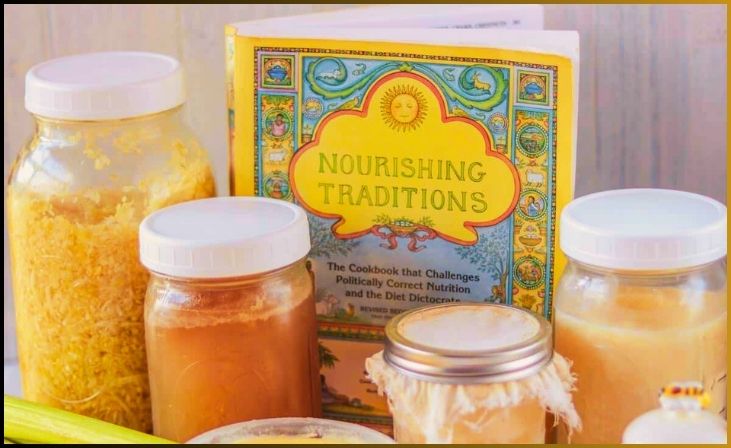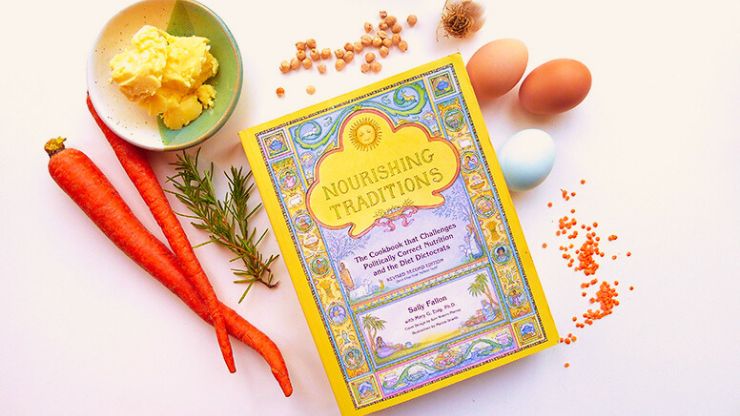At Fermentools, we want you to have the best knowledge about fermenting foods possible. That is why we like to share different resources with you. I hope you enjoy this review of Nourishing Traditions by Sally Fallon.
Nourishing Traditions is half a cookbook and half informative nutrition that is likely the opposite of what you’ve heard from any conventional nutritionist. Sally Fallon writes with a simple, and different, understanding of health–just as you cannot build a sound house with rotted wood, so you cannot build a healthy body when feeding it nutritionally barren foods. There is a strong emphasis on the nutritive value of different foods and preparations and the high value of fats and other nutrient-dense foods. For me, however, the most fascinating part of this book is the informative sidebars, particularly around the various fermented foods.
While cooking in general is a strong focus of this book, there is a wide variety of different ferments covered as well. From classic fruit ferments to sauerkraut and kombucha, and several things in between, Nourishing Traditions has some fermented foods for every taste.
A Book Review About Nourishing Traditions
Step into the world of holistic nutrition and culinary wisdom with our review of “Nourishing Traditions.” Authored by Sally Fallon and Mary G. Enig, this groundbreaking book explores traditional and nutrient-dense cooking methods, challenging modern dietary norms. Join us on a journey through the pages of this transformative guide as we delve into the principles of nourishment that have captivated readers and chefs alike for years.
Also, Read Other Book Reviews
One of my favorite informative parts of Nourishing Traditions is the historical aspects of fermentation. Historical marmalade is a perfect example. Today, marmalade is a sugared, heat-treated, and basically non-nutritive spread. But, that was not the case historically. Oranges were grown in southern Spain, but shipping them by sea was not always an efficient trip. As a result, instead of packing them in crates or boxes as fresh oranges, they were packed in barrels with layers and layers of salt. As a result, when the orange barrels reached England after months of sea travel, they were a salty, sour, and naturally fermented marmalade!
Don't just scroll, subscribe!
BuzzTrail's unique web-stories are the cure for boredom you've been waiting for.
Marmalade is just one of the fascinating foods, which was historically fermented and now is not, that Nourishing Traditions covers. Many of the ferments have sidebars talking about studies, and other observations, of the health impact of the food, and the powerful impact natural ferments can have on your health.
Another interesting angle is the instructions for preparing grains, pulses, beans, and bread, all of which involve some form of fermentation or soaking. With the grains and seeds, the pre-fermenting breaks down indigestible parts, particularly phytates which can block mineral absorption in the gut, and increase digestibility, flavor, and general nutritive value. Several recipes offer an addition of more non-mainstream grains, like spelled and buckwheat instead of wheat, to provide more nutritional value from your food.

One of the recipes I would like to try is the “Yogurt Dough” recipe, as an alternative for pie and tart shells. The recipe includes yogurt, which will add lacto-fermentation during the overnight resting period, and make the resulting tart shell similar to a well-fermented sourdough.
Whether you want a savory dish or a sweet and nutritive dessert, you can find a recipe, and fascinating anecdotes about it, in Nourishing Traditions. There are recipes catering to nearly all needs, including healthy snack and finger food options, desserts, breads, main dishes, side dishes, and even drinks. One fun thing about the drink recipes is that many of them are fermented, too.
Most of the recipes in Nourishing Traditions require some level of pre-planning, soaking, and extra preparation time. The resulting healthy and nutritive food is well worth that bit of extra effort. While the fermented veggies, grains, legumes, and drinks, are some examples of useful recipes and fun foods, there is way more within this cookbook than can be listed. If I had to choose one all-purpose cookbook to have on hand, I would go with Nourishing Traditions. You learn something new every time you open it, cook with it, or just browse for new food ideas.
Final Thoughts
“The Nourishing Traditions Book” is a valuable resource for anyone seeking to embrace a more nourishing and sustainable approach to food. With its emphasis on traditional cooking methods, whole foods, and nutrient-dense ingredients, this book offers a wealth of information and practical guidance. Whether you’re a beginner or an experienced cook, “Nourishing Traditions” will inspire you to explore the world of traditional cooking and discover the joys of nourishing your body with wholesome, delicious meals. Embrace the wisdom of traditional diets and let “Nourishing Traditions” be your guide on the journey to better health and well-being.
FAQs
What makes “Nourishing Traditions” stand out in the realm of nutrition books?
What makes “Nourishing Traditions” stand out in the realm of nutrition books?
“Nourishing Traditions” stands out for its emphasis on traditional, whole foods and cooking methods. It challenges conventional dietary advice, advocating for nutrient-dense choices and time-honored practices that have sustained generations.
Is this book suitable for individuals with dietary restrictions or specific health concerns?
Is this book suitable for individuals with dietary restrictions or specific health concerns?
Yes, the book addresses various dietary concerns and restrictions by providing adaptable recipes. It emphasizes the importance of tailoring nutrition to individual needs, making it a valuable resource for those with specific health considerations.
How does “Nourishing Traditions” incorporate cultural and historical aspects into its approach to nutrition?
How does “Nourishing Traditions” incorporate cultural and historical aspects into its approach to nutrition?
The book seamlessly weaves cultural and historical context into its nutritional teachings. It explores the traditional diets of diverse societies, showcasing how ancestral eating habits can inform a healthful and nourishing approach to modern nutrition.
Can beginners in the kitchen benefit from the recipes and information in this book?
Can beginners in the kitchen benefit from the recipes and information in this book?
Absolutely! “Nourishing Traditions” caters to individuals of all culinary skill levels. It not only provides detailed recipes but also educates readers on the fundamental principles of traditional cooking, making it accessible and enriching for kitchen beginners and seasoned chefs alike.

